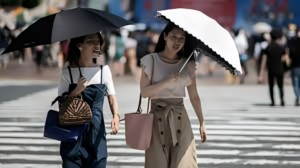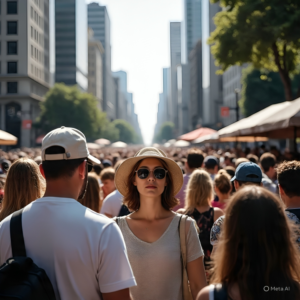Japan Faces Devastating Early Summer Heatwave as Temperatures Soar Above 35°C
Introduction
As July dawned, Japan found itself grappling with an unusually intense heatwave, with many regions—particularly in the west—recording daytime highs exceeding 35°C (95°F). Meteorological agencies issued heatstroke alerts and urged residents to stay indoors during peak afternoon hours. This surge in temperature far outpaced seasonal norms, catching communities off guard and stressing public health systems. Amid growing concerns around climate change and its impacts, experts warn that such extreme weather events may become increasingly common, underscoring the need for immediate preparedness and long‑term adaptation strategies.

Impact on Public Health and Daily Life
Short, scorching days have led to a sharp rise in heat‑related illnesses. Hospitals in affected prefectures report a surge in heatstroke consultations, particularly among the elderly and children. Key challenges include:
- Vulnerable populations: Seniors living alone and children playing outdoors are at greatest risk.
- Strain on emergency services: Ambulance call‑outs for heatstroke have increased by over 20% in some cities.
- Workplace safety: Outdoor laborers—construction crews, farmers, postal workers—face dangerous conditions, prompting calls for revised work schedules.
Local governments have opened “cooling centers” in community halls, libraries, and shopping malls, offering air‑conditioned respite. They’ve also launched awareness campaigns via social media and public broadcasts, advising citizens to stay hydrated, wear lightweight clothing, and monitor vulnerable family members.
Underlying Causes and Climate Context
While summer heat is typical in Japan, meteorologists identify several factors behind this early, intense spike:
- High‑pressure dome: A persistent subtropical high‑pressure system over the Pacific has prevented cooler air masses from moving in.
- Urban heat islands: Concrete, asphalt, and dense building coverage trap and radiate heat, amplifying urban temperatures by several degrees compared to surrounding rural areas.
- Climate change trends: Over the past few decades, Japan’s average summer temperature has risen by roughly 1.2°C, with extreme heat days becoming more frequent.
Experts warn that without significant reductions in greenhouse gas emissions and urban planning reforms—such as green roofing and expanded tree cover—these heatwaves will only intensify, posing growing threats to public health and infrastructure.
Best Practices for Staying Safe
Preventing heat‑related harm requires both individual action and community support. Recommended measures include:
- Hydration: Drink water regularly, even without feeling thirsty. Avoid excessive caffeine and alcohol.
- Cool environments: Seek air‑conditioned spaces or use fans, cool towels, and misting sprays.
- Appropriate attire: Wear loose‑fitting, light‑colored clothing; use wide‑brimmed hats and UV‑blocking sunglasses outdoors.
- Timing outdoor activities: Schedule exercise or errands for early morning or late evening when temperatures are lower.
- Buddy system: Check on elderly neighbors and relatives at least twice daily.
Employers are also encouraged to revise shift patterns and provide mandatory rest breaks, while schools have been advised to shorten outdoor recess and install shaded play areas.

Real‑Life Examples: Community Efforts in Action
- Kobe’s Cooling Buses: The city of Kobe has deployed specially outfitted buses with powerful air‑conditioning to roam neighborhoods, allowing residents without home cooling to find refuge.
- Osaka’s “Green Street” Initiative: Volunteers plant temporary foliage and install misting arches along busy pedestrian streets, lowering ambient temperatures by several degrees.
- Tokyo’s Hydration Stations: Free water refill stations set up in public parks and train stations encourage commuters and tourists to refill and stay hydrated.
These grassroots initiatives illustrate how local creativity and collaboration can mitigate the worst effects of extreme heat, saving lives and easing demands on emergency services.
Long‑Term Strategies: Building a Heat‑Resilient Future
To address recurring heatwaves, experts recommend a multifaceted approach:
- Urban greening: Expand parks, green belts, and rooftop gardens to absorb sunlight and provide shade.
- Building codes: Mandate reflective roofing materials and better insulation to reduce indoor temperatures.
- Early warning systems: Enhance forecasting accuracy and communication channels to ensure timely alerts.
- Public awareness campaigns: Integrate heat‑risk education into school curricula and community programs.
- Healthcare preparedness: Train medical professionals for surge capacity and heat‑stroke treatment protocols.
Implementing these measures will require cooperation between national and local governments, private sector stakeholders, and community groups. The costs of inaction—rising healthcare expenses, reduced labor productivity, and potential loss of life—far outweigh the investments in resilience.
Conclusion
Japan’s early summer heatwave serves as a stark reminder of our climate’s changing dynamics and the human toll of extreme weather. By combining immediate relief efforts with strategic, long‑term planning, communities can protect the most vulnerable, sustain daily life, and pave the way for a more heat‑resilient society. As citizens heed health advisories and authorities enact adaptive measures, Japan’s response can become a global model for confronting the challenges of a warming world.